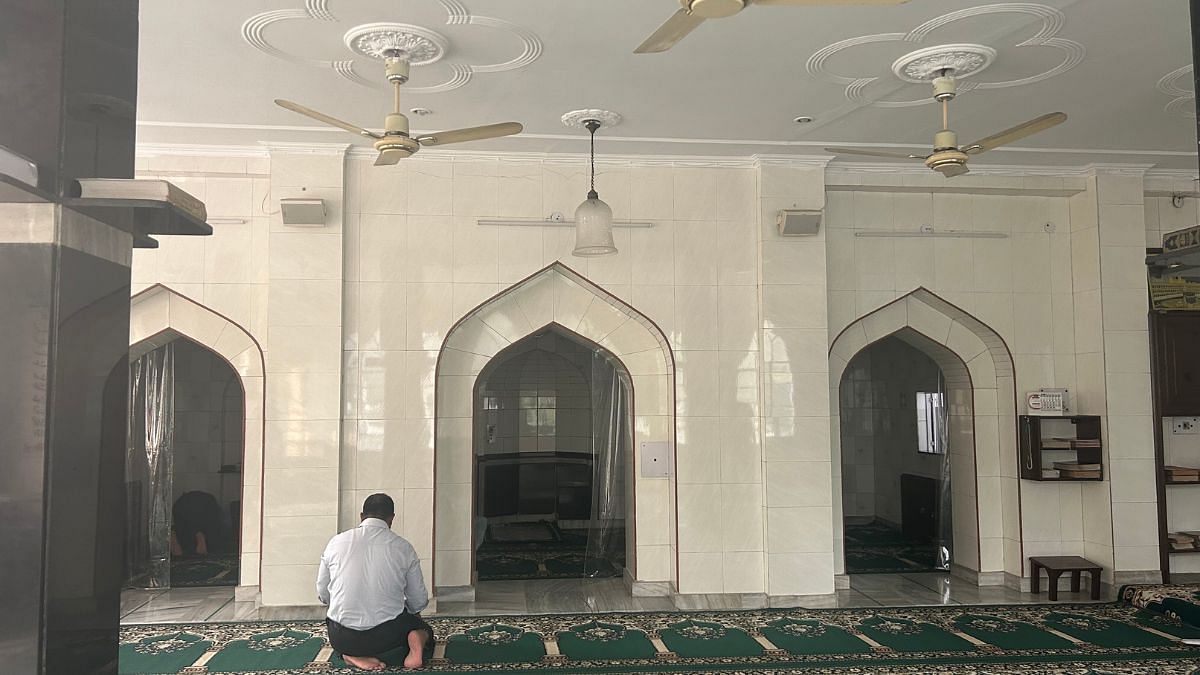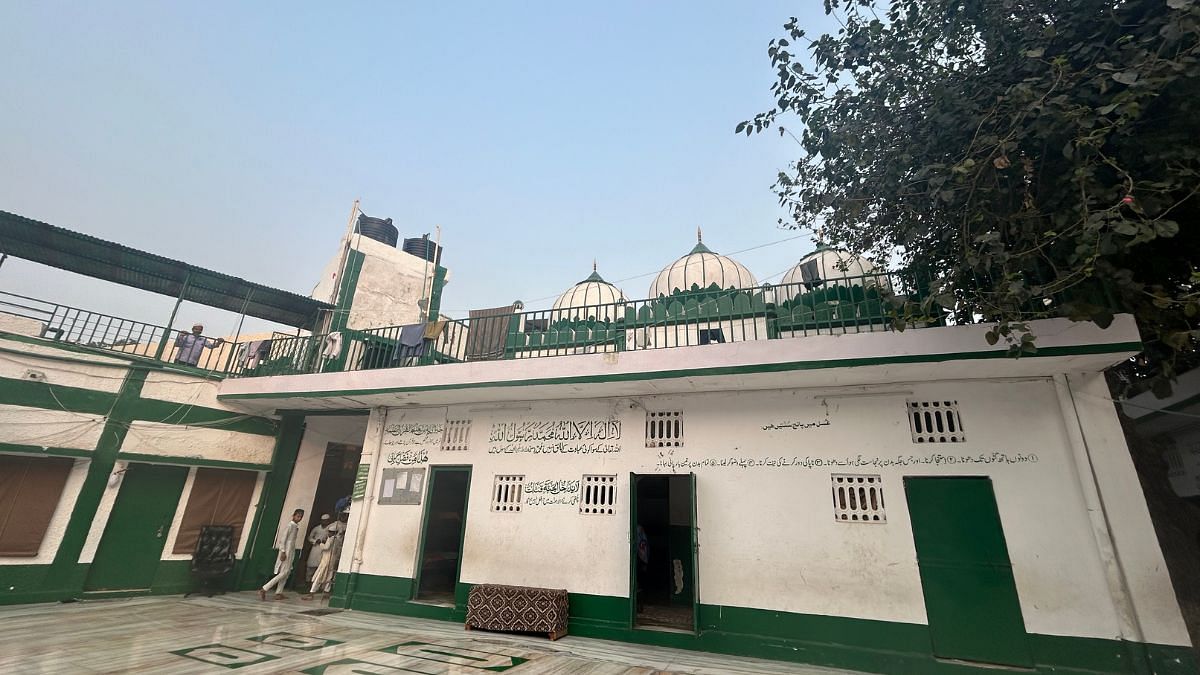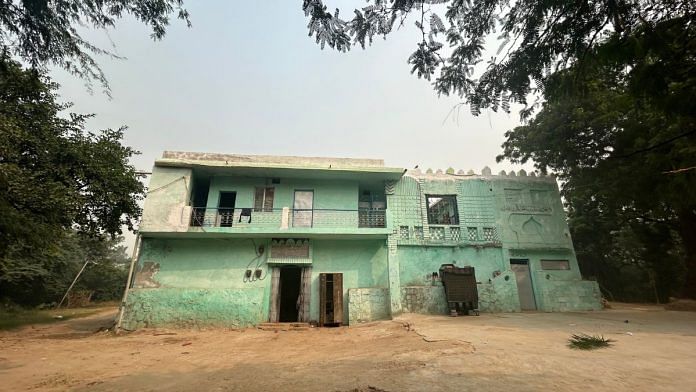New Delhi: Sunlight streams through the holes in the rusted tin roof of Shahi Masjid in New Delhi’s Dhaula Kuan. The mosque is in a state of disrepair as is the adjacent Kangal Shah graveyard, and the madrasa behind it where a group of children are preparing their meals. The walls are crumbling, and the green paint is peeling, but hundreds of Muslims gather here to pray every Friday. Now, everyone is on edge because Shahi Masjid is slated to be demolished by the Delhi Development Authority.
The DDA claims that the mosque and madrasa are part of Central Ridge, a protected forest area where residential and commercial activities are prohibited, and that permission to raze the structure has been granted by the Delhi government’s Religious Committee. Now its fate will be decided by the Delhi High Court.
Members of the Muslim community, the mosque committee, and the Imam claim that Shahi Masjid is more than a hundred years old.
“How can it suddenly become an encroachment? This is our history,” says Mohammad Younus, 60, the general secretary of the mosque committee.

The same question was raised when bulldozers razed Akhunji Masjid, a 13th-century mosque, and the adjoining madrasa in Mehrauli less than a month ago on 30 January. The reason cited was that the mosque was situated in the southern portion of the Delhi Ridge, which forms part of the Northern Aravalli leopard wildlife corridor. In April 2023, the New Delhi Municipal Council (NDMC) tore down a portion of a mosque in the city’s Bengali Market as part of an anti-encroachment drive. And another mosque about 10 kilometres away from Shahi Masjid has also been served a demolition notice.
Younus is worried that the bulldozers will come for Shahi Masjid as well. The committee approached the DDA after the demolition notice was served last year. “But the authorities told us that no mosque ever existed here,” said Younus.
The committee of the Shahi Masjid, madrasa and qabristan (graveyard) petitioned the Delhi High Court, which in November 2023 directed the DDA not to take any coercive action until 31 January 2024. When the development authority petitioned for the removal of the stay, the Delhi High Court on 14 February issued notice to the committee. The court has asked the committee to file a reply within 10days of the DDA seeking the removal of the stay.
“On what basis do you want to take the action? You make a clear and cogent case. Give me the exact dimensions. What is that you want to remove and why?’ the judge said, asking the DDA’s legal counsel to explain all these things when the matter is heard again on 29 February.
Also read: Lutyens Delhi meet to ‘save democracy’ becomes a gathering of old friends—’too little, too late’
Lived memories
Mumtaz Khan’s family members have been caretakers of Shahi Masjid for three generations. His father and grandfather, who were caretakers before him, are buried at Kangal Shah graveyard within the mosque compound.
According to Khan, the mosque was built by a Sufi saint Baba Kangal Shah over 100 years ago. Its oral history, passed down through the generations, describes the initial structure as a small, dark room made with stones and mud. In the next 100 years, it was renovated to provide shelter to hundreds of travellers and devotees. Over time, the graveyard and the madrasa came up next to the mosque.
Delhi is known for its centuries-old mosques. “Since no decision has been taken about them (mosques), the DDA is going on and demolishing them selectively. Dhaula Kuan is one of these mosques,” historian Sohail Hashmi told ThePrint.
Hashmi questioned the DDA’s authority over the discretion to demolish heritage structures. “It should be ASI and departments of archaeology. It is not the religious department of DDA that can make a decision,” he said. The historian added that a long-term policy has to be evolved in consultation with area experts, historians, and archeologists. And all old structures need to be listed.
“On Fridays, more than 250 people gather here for afternoon prayers,” added Younis, who runs a car workshop in Dhaula Kuan and has been associated with the mosque over the last 35 years.
The madrasa behind the Shahi Masjid is home to around 50 students, many of whom are orphans. “Where will these students go?” asked Younis.

About 10 kilometres away, the two-storey Sunehri Bagh Mosque near Udyog Bhawan is in good condition, but it also received an eviction notice in July 2023. It stands at the intersection of Maulana Azad Road, Motilal Nehru Marg, and Kamraj Road.
On the opposite end of the road were two mazars that were demolished in April 2023, as part of New Delhi Municipal Corporation’s anti-encroachment drives. “But those mazars and this mosque existed way before the footpaths were created,” said Abdul Aziz, 48, the Imam of Sunehri Bagh Mosque.
Hashmi said that the Sunehri Bagh Masjid is a class 3rd structure categorised on the basis of architectural and historical importance, as per the Archaeological Survey of India, adding that while it might not have the importance of a class 1st structure, it acquired great political importance subsequently.
Maulana Hasrat Mohani, a freedom fighter who later became a member of a constituent assembly, famed for the anti-colonial slogan “Inquilab Zindabad,” was a frequent visitor to this mosque, said Hashmi. “This mosque is very closely connected to our freedom struggle.”
On 24 December, the NDMC published a notice in various newspapers seeking public opinion on the demolition of the mosque to ease traffic congestion in the area.
“I was a child when Indira Gandhi would pass by the road. Her vehicle would slow down in front of the mosque, and she would wave at us and smile. Rajiv Gandhi would do the same. For decades, nobody disturbed us or anyone’s business,” said Aziz.
Little is known about when the mosque was built, but according to historian Swapna Liddle, its architecture could date back to the 17th century or earlier, predating the nearby roads that were built between 1910 and 1920.
Prominent Muslim politicians have offered namaz in the mosque in the past, says Aziz. “Ghulam Nabi Azad, Mansoor Ali Khan Pataudi, CK Jaffer Sharief, Saleem Iqbal Shervani, Ghani Khan Choudhury and many others would come here for namaz,” he said. “It’s an important asset for the history of Muslims in Delhi.”
Also read: How was JNU imagined? Design archives show the planning of a micro-city and a nation
New India, old India
The fate of many places of worship—across all religions—has become a contentious issue pitting New Delhi’s Lieutenant Governor VK Saxena against the Aam Aadmi Party (AAP) government.
Last February, former deputy Chief Minister Manish Sisodia held a press conference urging Saxena to prevent the demolition of temples, mazars and gurudwaras for infrastructure projects. Sisodiaclaimed he had “19 files to demolish 67 temples, six mazars (shrines), and one gurdwara”. In fact, that month itself, a part of the Pracheen Shiva temple and a mosque at ITO were demolished by the Public Works Department (PWD) following the Delhi High Court order.
ThePrint reached out to the DDA, which refused to comment on the matter. And NDMC officials directed the queries to the Land and Development Office (L&DO), whose officials were unavailable. The story will be updated with their response.

Meanwhile, at the Bengali Market mosque, community members fear that the rest of the structure will be demolished as well. Over a hundred children live in the madrasa, earning it the moniker ‘Bachhon wali masjid’ among local people.
“The reason that they gave us for the demolition was that we had encroached 100 metres from the road. However, the wall was built with the mosque, so could it have encroached on the road?” said Hafiz Matlub, general secretary of the local mosque committee, while questioning whether the authorities cared about the city’s heritage.
But deciding what qualifies as heritage and what does not has always been a contentious issue, dating back to colonial times.
Who can prove that a 150-year-old mosque is encroaching, asked architect and urban planner AG Krishna Menon. He stressed the importance of public consultation when it comes to the fate of old structures. Mosques, mazars, temples, and graveyards are the repository of a community’s memories.
“Urban landscapes are built on layers of history. These mosques and mazars are the layers of history on which Delhi is built,” he said. If removed, a city—however beautiful the end result may be—becomes “deadly boring”.
“Memory is very important. The narrative is that these demolitions are needed to build a new India. Of course, you can have a new India, but you can’t demolish old India for that. Just add new India to the old,” Menon added.
(Edited by Ratan Priya)



